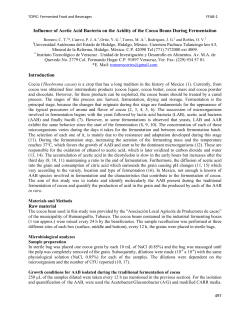
Ex # 24, p 61-64 API 20E Multiple Test Strip
Ex # 24, p 61-64 API 20E Multiple Test Strip Clinical Rapid Identification of Enterobacteriaceae and other Gram Negative Rods Additional references: 1. Textbook a. Ch 2. Photo Atlas a. p 45-46 Notes: 1. Prepare a suspension of the bacteria in the saline tube: Inoculate a large colony (2-3mm diameter) of the bacterium (pure culture) into the 0.85% NaCl solution, making sure that the suspension is homogenous and without clumps of floating bacteria 2. Inoculate the API strip: a. Holding the strip at a slight angle up from the table top, inoculate the bacterial suspension into each well with a sterile pipette b. Touch the end of the pipette to the side of the cupule, allowing capillary action to draw the fluid into the well as you slowly squeeze the bulb. This should eliminate any bubbles forming in the wells. Each well should be filled up to the neck (see diagram) c. CIT, VP, and GEL have boxes around their names. These test wells will be filled all the way up to the top of the well d. LDC, ODC, ADH, H2S, and URE are filled as described in step B, but they will then be filled up to the top with sterile mineral oil 3. Incubate the strip in its chamber: a. The bottom of the incubation chamber has small indented wells: fill it with water just enough to fill these indentations b. Place the strip onto the bottom of the chamber. There should not be so much water that it slops onto the top of the API strip c. Place the top of the incubation chamber over the bottom, and label it d. Place the strip at 37o C for 18-24 hours 4. Interpretation: a. Add the proper reagents to the compartments: I. II. III. 1 drop of Kovac's to the IND (read within a couple of minutes) 1 drop of Barritt's A and B to VP (a + reaction may take up to 10 minutes) 1 drop of FeCl3 to TDA b. Read all other tests as described (chart below) without reagents c. Record results on the diagram handed out to you in lab I. II. 1, 2, or 4 points for + reaction, 0 points for - reaction The oxidase test reaction should be negative, and is added as the last test result d. Three test reactions are added together to give a 7-digit number, which can then be looked up in the codebook READING THE API 20 TESTS SUBSTRATE REACTION TESTED - RESULTS + RESULTS ONPG ONPG beta-galactosidase colorless yellow ADH arginine arginine dihydrolase yellow red/orange LDC lysine lysine decarboxylase yellow red/orange ODC ornithine ornithine decarboxylase yellow red/orange CIT citrate citrate utilization pale green/yellow blue-green/blue H2S Na thiosulfate H2S production colorless/gray black deposit URE urea urea hydrolysis yellow red/orange TDA tryptophan deaminase yellow brown-red IND tryptophan indole production yellow red (2 min.) VP Na pyruvate acetoin production colorless pink/red (10 min.) GEL charcoal gelatin gelatinase no diffusion of black black diffuse GLU glucose fermentation/oxidation blue/blue-green yellow MAN mannitol fermentation/oxidation blue/blue-green yellow INO inositol fermentation/oxidation blue/blue-green yellow SOR sorbitol fermentation/oxidation blue/blue-green yellow RHA rhamnose fermentation/oxidation blue/blue-green yellow SAC sucrose fermentation/oxidation blue/blue-green yellow MEL melibiose fermentation/oxidation blue/blue-green yellow AMY amygdalin fermentation/oxidation blue/blue-green yellow ARA arabinose fermentation/oxidation blue/blue-green yellow OX oxidase oxidase colorless/yellow violet QUESTIONS: 1. What is the purpose of the water in the tray? 2. What is the function of the mineral oil? 3. What are the advantages of this test (compared to regular biochemical tube media)? 4. What are the disadvantages of this test? Good web sites for ‘extra’ information: http://www.jlindquist.net/generalmicro/102bactid2.html www.biology.ed.ac.uk/.../microbes/proteus.htm http://pages.usherbrooke.ca/biomedias/techniques_microbio.htm O AL OCHUT I GGMI S R S MA A culture N V D D D I 2 R D N E L A N O H A E M R identification no. P P HC C T S E AD L UN OR AC L Y A G 8101 + – + + – – – – + – – + + – + + + + – + Escherichia coli
© Copyright 2025





















